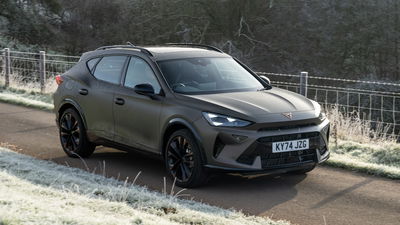Jeep Renegade e-Hybrid Review: Updated Tech Can’t Mask Flaws

Pros
- Still has visual character after all these yearsRoomy interior for a car of its size
Cons
- Sluggish hybrid powertrain and gearboxReally feeling its age inside
We’d forgive you for forgetting that the Jeep Renegade is still on sale. When it was released back in 2014, the littlest Jeep was the first product of the Fiat-Chrysler merger with the famous seven-slot grille, and was tasked with making the brand a mainstream player in Europe.
It was a success in this regard, massively increasing Jeep’s presence in Europe. It was the brand’s first car to be built outside North America, with Euro-market cars being produced alongside the Compass in Italy, where Jeep has pretty much been adopted as a home-grown 4x4 brand.

Of course, a lot has changed for Jeep since then. Parent company FCA has been further subsumed into the industry giant that is Stellantis, which has produced its own Euro-centric baby Jeep in the form of the capable, characterful little Avenger.
That car, while similarly sized, is based on much newer hardware, available with a broad range of powertrains, and significantly undercuts the Renegade on cost unless you go for the full EV version. Prices for the Renegade e-Hybrid start at £30,510, climbing to £33,010 for the range-topping Summit version driven here.
It leaves you asking why Jeep has kept the ageing Renegade around, but the brand is confident that it has its own fanbase and isn’t at risk of having its sales cannibalised by the new kid.

As a result, it’s been given another refresh as it enters its tenth year on the market. It’s now exclusively electrified, with two powertrain options: the front-wheel drive, mild-hybrid e-Hybrid and the four-wheel drive, plug-in hybrid 4xe (pronounced ‘four-by-e’). It’s the former we’ve driven here, which pairs a 1.5-litre turbocharged four-cylinder with a 48v hybrid system. It sends 128bhp and 177lb ft of torque to the front wheels via a seven-speed dual-clutch automatic. You’re looking at a 9.7-second 0-62mph time and a 119mph top speed.
The interior has been given a tech-lift, too. A new 10.1-inch touchscreen, with CarPlay and Android Auto connectivity, has been integrated – not particularly neatly – into the dash. The gauge cluster is now fully digital. The new native infotainment system is based on Android software.

A couple of screens, however, can’t truly mask the Renegade’s age. A lot of the fixtures and fittings date from less financially rosy days for both Fiat and Chrysler and don’t look or feel like they belong on a £30k car. On the flip side, its age means there’s less risk of certain core functions being buried within a touchscreen like they are on the Avenger.
The Renegade’s boxy, upright stance does imbue it with very good headroom for a car of its stature, and the inside is a generally roomy, airy and comfy place, especially with the Summit’s twin sunroofs. The front footwells are curiously narrow, though.

On the move, the new powertrain can’t really hide the Renegade’s flaws, either. The ability to manoeuvre at low speeds on pure electric power is welcome, but when the petrol engine kicks in, it’s gruff, unresponsive and very lacking in low-down grunt. The gearbox, too, is slow to respond when you encourage it to downshift, although changes are smooth and fuss-free when they do eventually happen.
Things don’t get much better in the corners, where the steering is vague and unresponsive, even at low speeds, and the body rolls about. The ride, meanwhile, is acceptable if a little firm at times. It could be argued that the ponderous handling is a trade-off for the genuine off-road ability that the Renegade has proven it has in the past. This is a fair point for the four-wheel drive 4xe version, but on the front-drive e-Hybrid, it loses credence, and you’re left wondering how a relatively small car could feel so vague in its movements.

The Renegade has two major things going for it. One is its boxy, characterful styling, which is surely the reason it’s amassed enough of a following for Jeep to keep it around this long. The other is the genuine off-road ability offered by the four-wheel drive Trailhawk version, and with an Avenger 4xe arriving later this year, that advantage might soon be diminished.
As for the e-Hybrid, it’s ever so slightly roomier than the Avenger, but besides that, it’s a much weaker car in every regard, and spec-for-spec, a more expensive one too. You’d have to be absolutely in love with its styling, or a fan of wearing tall hats while driving, to choose it over the new car. Unfortunately, the Renegade doesn’t display much mastery, but plenty of ill behaviour.















Comments
No comments found.